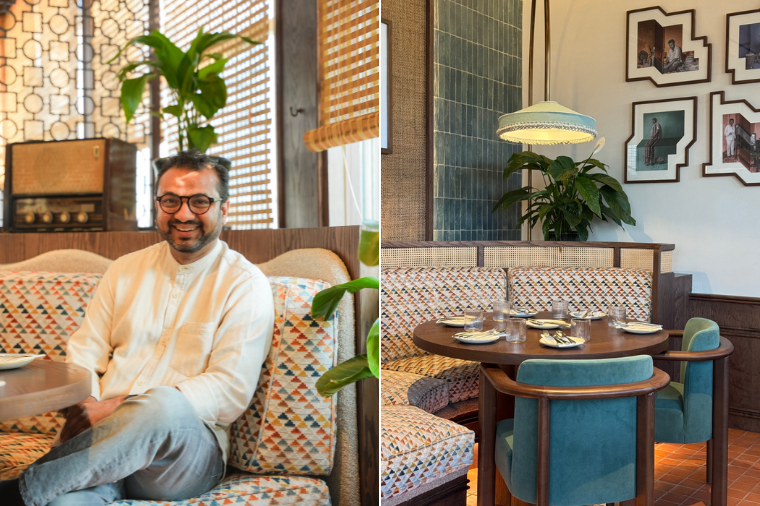Born to bring forgotten Indian recipes to the forefront, Chef Naved Nasir is the brainchild behind Dubai’s Khadak.
Behind the highly sought-after Dishoom in London, he opened his first restaurant in Dubai to bring a casual Indian dining experience deeply rooted in tradition.
To provide that depth artists flown in from India have added a unique layer to Khadak’s design. Here each piece of art tells its own story, transporting diners to India. Beyond the food, Khadak’s space is infused with a narrative that celebrates the vibrant cultures of India, merging artistic expressions with culinary heritage.
Situated in Jumeirah, the menu showcases rarely-seen recipes in a new light, with his expertise in the world of food.
To delve into Chef Naved’s story, Emirates Man sat down with him to see how Khadak’s making its mark in the UAE.
Talk us through your background.
I’ve spent much of my career introducing Indian cuisine to a global audience, most notably as Chef Director at Dishoom in London. Before that, I trained at the iconic Bukhara in New Delhi and had the privilege of working under the late Chef Imtiaz Qureshi in Mumbai. For me, food has always gone beyond taste—it’s about storytelling, evoking nostalgia, and bringing people together around a shared experience.
What inspired you to launch Khadak in Dubai?
Dubai felt like the right place to revive and share the stories of India’s forgotten food culture. With Khadak, I wanted to go beyond the expected—to bring back lost recipes, age-old techniques, and the spirit of iconic food streets across India. It’s about presenting these bold, nostalgic flavors with care and intention, in a city that truly celebrates culinary storytelling.

How did you adapt Dishoom’s success formula for the Dubai audience while keeping Khadak unique?
I never intended to replicate Dishoom. What resonated in London wouldn’t necessarily translate here. Dubai has a rich love for Indian food, but I felt there was space to spotlight lesser-known culinary traditions. Khadak brings forward forgotten recipes, cooked with grit and fire, in a space that feels warm yet refreshingly distinctive. Our dishes and interiors pay tribute to the iconic food shops in India. This was important to us as many have weathered decades of change while holding onto their originality.
How do you weave storytelling into the dining experience at Khadak Dubai?
Every dish at Khadak has a story. Take our Shabrati Nihari—it’s inspired by how nihari was traditionally slow-cooked overnight and served at dawn to both laborers and nawabs. The dish nods to Haji Shabrati in Old Delhi. Our Shami Kebab honors the legendary Noor Mohammadi in Mumbai’s Bhendi Bazaar, a restaurant with a history of over 100 years. These aren’t just recipes—they’re cultural touchstones revived on the plate.
View this post on Instagram
What are some of the key dishes to try at the restaurant?
The Khadak Daal is definitely a highlight, it’s slow-cooked for hours to develop a rich, smoky depth. The Shabrati Nihari is indulgent yet balanced, with melt-in-your-mouth meat in a deeply aromatic broth. Our Morel Cheese Kulcha is crisp on the outside and filled with umami-packed morels, herbs, and cheese. The Jackfruit Haleem is another standout—luxuriously slow-cooked with an unexpected hero ingredient.
What were some of the most fascinating forgotten Indian recipes you uncovered while researching for Khadak?
One that truly stood out was a Rampuri-style Moong Dal Gosht—my personal favorite, and a treasured family recipe. There’s only one aunt left in my family who still knows how to prepare it. We’ve revived it at Khadak using slow-cooked goat shanks, green moong dal, and a unique blend of spices that’s true to its heritage.
“Khadak is designed to feel like home – warm, soulful, and full of character.”
How do you balance nostalgia with innovation when reintroducing old dishes in a modern setting?
Innovation for me isn’t about deconstructing dishes into something unrecognisable. It’s about respecting tradition while refining technique, sourcing better ingredients, and deepening flavour. Nostalgia forms the foundation, but we build upon it through thoughtful execution. For instance, our reimagined Broccoli Bhel combines a street-favourite puffed rice dish with broccoli and nuts. Or take the Uthappam on our breakfast menu – it blends the classic with the freshness of avocado toast, creating a dish that feels both familiar and new.
What role does the design and ambiance of Khadak play in making these forgotten dishes more appealing to a global audience?
Khadak is designed to feel like home- warm, soulful, and full of character. From the woodwork to the tiles, from the soft lighting to the nostalgic details and murals, everything is carefully chosen to evoke a sense of belonging. The artwork on our walls tells its own story, drawing from the lost art of Daastangoi. My favorite spot is our cozy veranda, wrapped in bougainvillea, lime, and other plants, perfect for a quiet breakfast of bun maska and Irani chai.
What’s your take on the evolving perception of Indian cuisine in the UAE?
Indian food has always been respected here, but the perception is evolving. Diners are now more curious—interested in regional specialties, lesser-known techniques, and flavors that go beyond just heat. There’s a hunger for depth and storytelling, and that’s a very promising shift.
How does Khadak aim to shape the future of Indian dining in Dubai?
We want people to rethink what Indian food can be. Not just what’s familiar, but what’s been forgotten—or never discovered. Khadak is not about being revolutionary; it’s about reviving lost traditions and reimagining them with care. If we can spark a deeper connection to Indian cuisine, then we’re doing something meaningful.
– For more on luxury lifestyle, news, fashion and beauty follow Emirates Woman on Facebook and Instagram
Images: Supplied & Feature Image: Instagram @khadak











